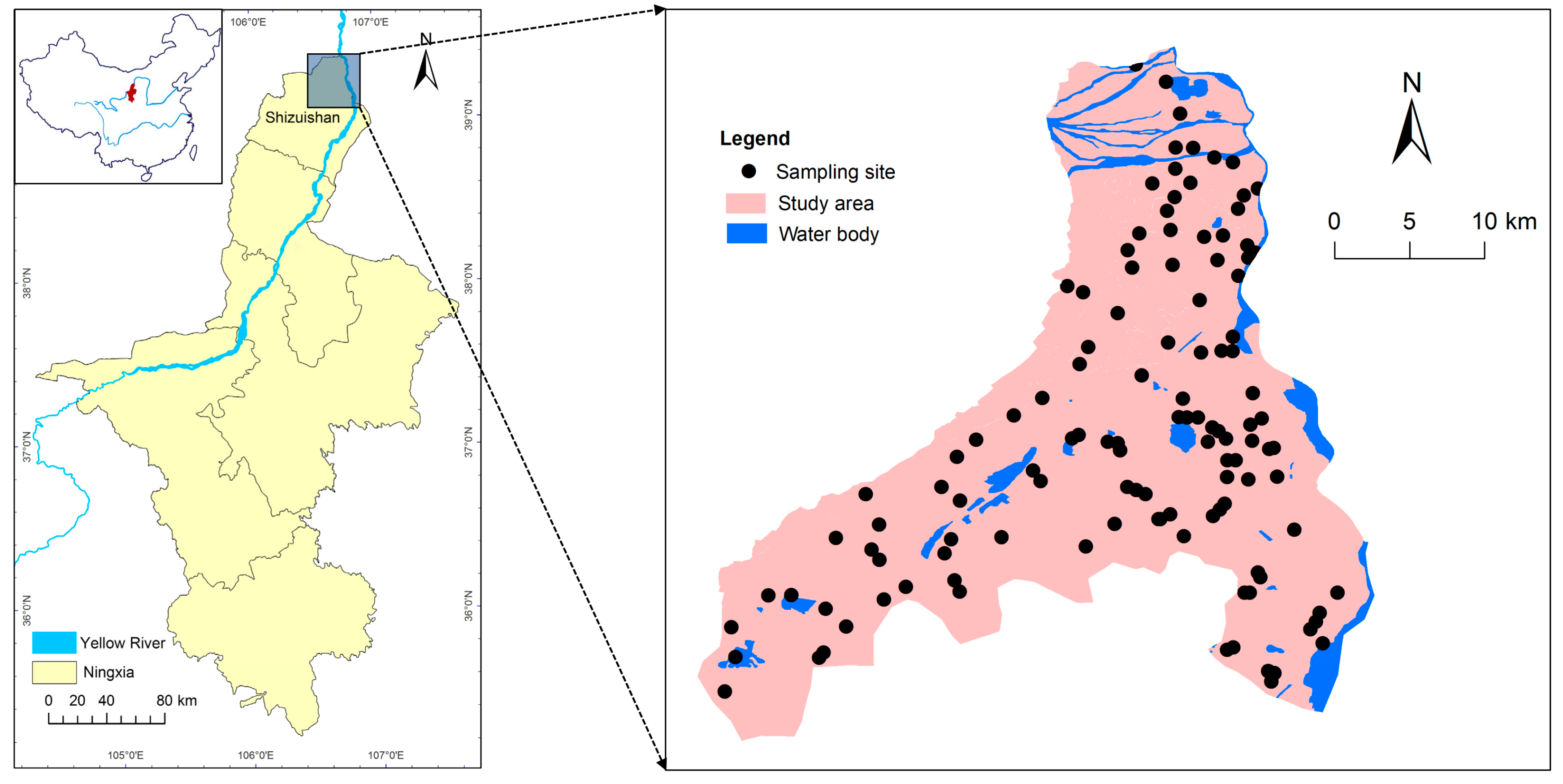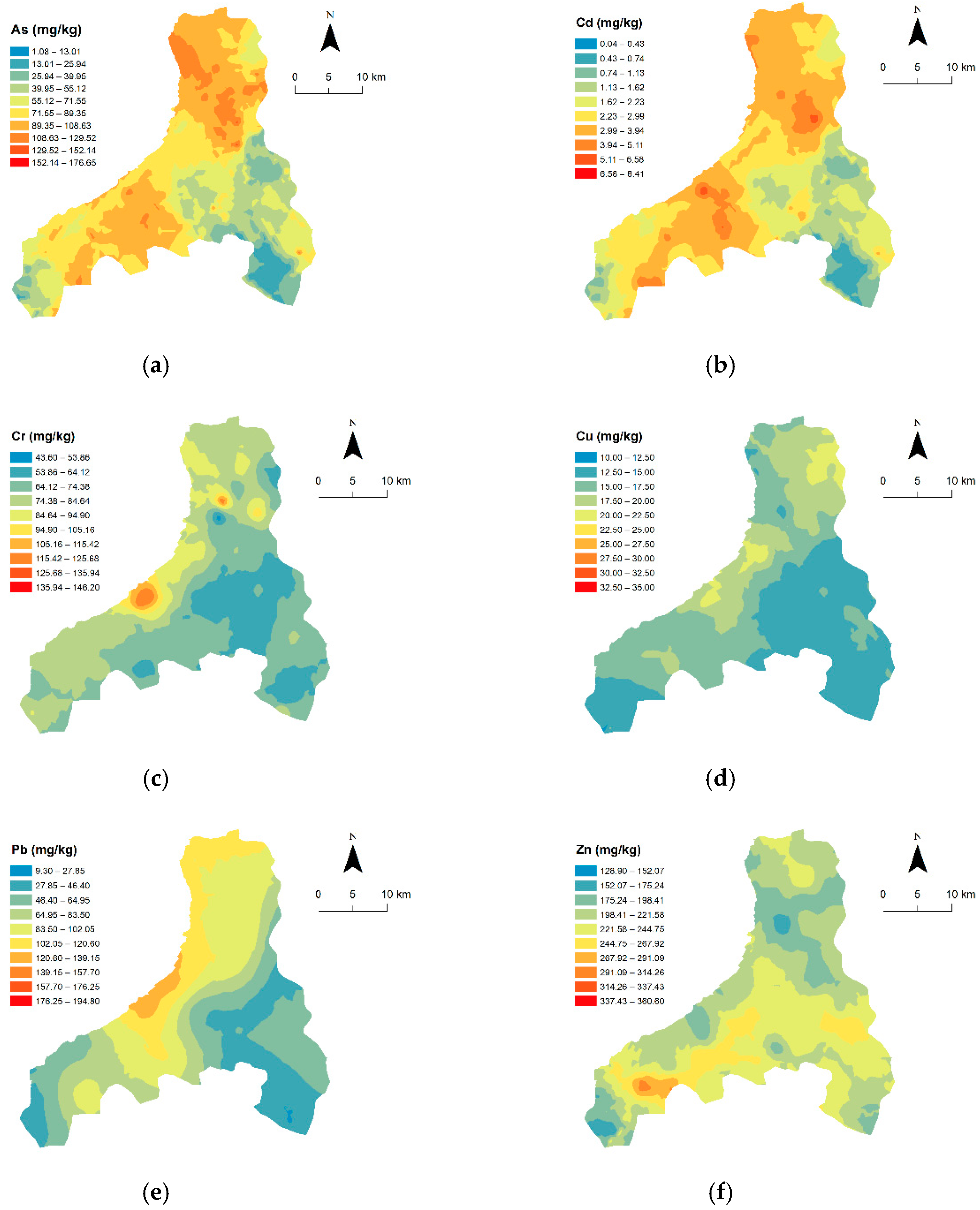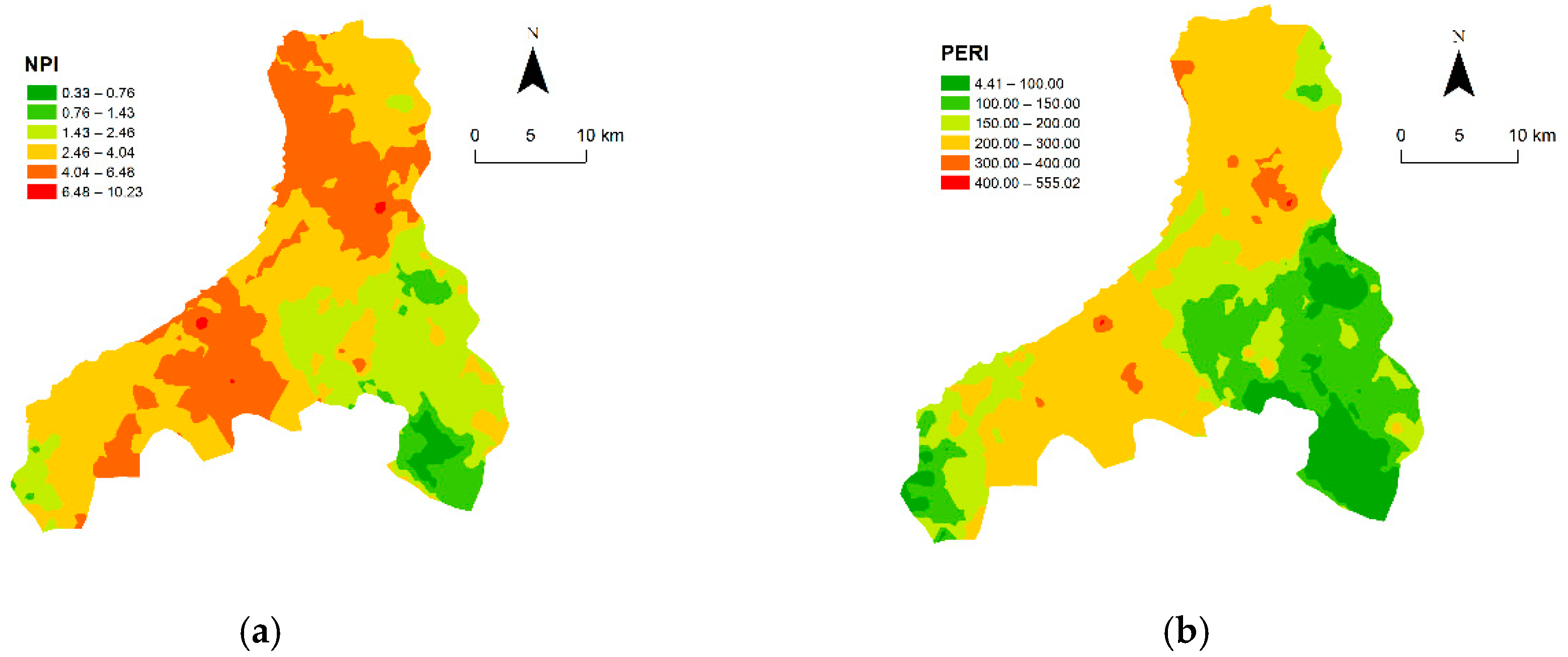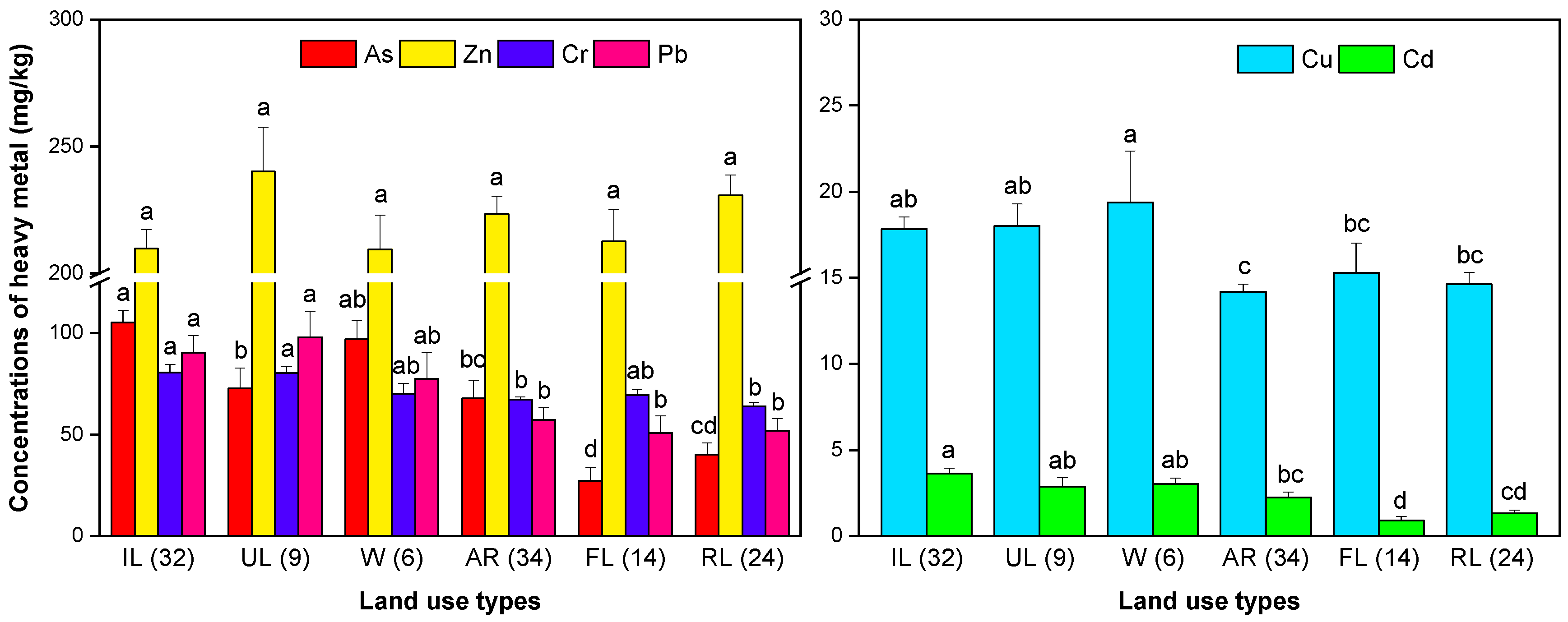Trace Elements in Soils of a Typical Industrial District in Ningxia, Northwest China: Pollution, Source, and Risk Evaluation
Abstract
1. Introduction
2. Materials and Methods
2.1. Study Area
2.2. Soil Sampling and Analysis
2.3. Assessment of Soil Pollution
2.4. Statistical Analysis and Spatial Distribution
3. Results and Discussion
3.1. Concentrations of Trace Elements
3.2. Identification of Trace-Element Sources
3.3. Spatial Distribution of Trace Elements
3.4. Environmental Risk Assessment of Trace-Element Pollution
3.5. Effects of Land-Use Types on the Content of Trace Elements
4. Conclusions
Supplementary Materials
Author Contributions
Funding
Acknowledgments
Conflicts of Interest
References
- Hu, H.; Jin, Q.; Kavan, P. A Study of Heavy Metal Pollution in China: Current Status, Pollution-Control Policies and Countermeasures. Sustainability 2014, 6, 5820–5838. [Google Scholar] [CrossRef]
- Li, Z.; Ma, Z.; van der Kuijp, T.J.; Yuan, Z.; Huang, L. A review of soil heavy metal pollution from mines in China: Pollution and health risk assessment. Sci. Total Environ. 2014, 468–469, 843–853. [Google Scholar] [CrossRef] [PubMed]
- Nriagu, J.O. Global Metal Pollution: Poisoning the Biosphere? Environ. Sci. Policy Sustain. Dev. 1990, 32, 7–33. [Google Scholar] [CrossRef]
- Fernandez-Luqueno, F.; López-Valdez, F.; Gamero-Melo, P.; Luna-Suárez, S.; Aguilera-González, E.N.; Martínez, A.I.; García-Guillermo, M.; Hernández-Martínez, G.; Herrera-Mendoza, R.; Álvarez-Garza, M.A. Heavy metal pollution in drinking water-a global risk for human health: A review. Afr. J. Environ. Sci. Technol. 2013, 7, 567–584. [Google Scholar]
- Cui, Y.; Zhu, Y.-G.; Zhai, R.; Huang, Y.; Qiu, Y.; Liang, J. Exposure to metal mixtures and human health impacts in a contaminated area in Nanning, China. Environ. Int. 2005, 31, 784–790. [Google Scholar] [CrossRef]
- Mamat, Z.; Yimit, H.; Ji, R.Z.A.; Eziz, M. Source identification and hazardous risk delineation of heavy metal contamination in Yanqi basin, northwest China. Sci. Total Environ. 2014, 493, 1098–1111. [Google Scholar] [CrossRef]
- Qing, X.; Yutong, Z.; Shenggao, L. Assessment of heavy metal pollution and human health risk in urban soils of steel industrial city (Anshan), Liaoning, Northeast China. Ecotoxicol. Environ. Saf. 2015, 120, 377–385. [Google Scholar] [CrossRef]
- Liu, Y.; Xiao, T.; Baveye, P.C.; Zhu, J.; Ning, Z.; Li, H. Potential health risk in areas with high naturally-occurring cadmium background in southwestern China. Ecotoxicol. Environ. Saf. 2015, 112, 122–131. [Google Scholar] [CrossRef]
- Keshav Krishna, A.; Rama Mohan, K. Distribution, correlation, ecological and health risk assessment of heavy metal contamination in surface soils around an industrial area, Hyderabad, India. Environ. Earth Sci. 2016, 75, 411. [Google Scholar] [CrossRef]
- Dong, R.; Jia, Z.; Li, S. Risk assessment and sources identification of soil heavy metals in a typical county of Chongqing Municipality, Southwest China. Process Saf. Environ. Prot. 2018, 113, 275–281. [Google Scholar] [CrossRef]
- Wilcke, W.; Müller, S.; Kanchanakool, N.; Zech, W. Urban soil contamination in Bangkok: Heavy metal and aluminium partitioning in topsoils. Geoderma 1998, 86, 211–228. [Google Scholar] [CrossRef]
- Vink, R.; Behrendt, H.; Salomons, W. Development of the heavy metal pollution trends in several European rivers: An analysis of point and diffuse sources. Water Sci. Technol. 1999, 39, 215. [Google Scholar] [CrossRef]
- Wang, G.; Zhang, S.; Xiao, L.; Zhong, Q.; Li, L.; Xu, G.; Deng, O.; Pu, Y. Heavy metals in soils from a typical industrial area in Sichuan, China: Spatial distribution, source identification, and ecological risk assessment. Environ. Sci. Pollut. Res. 2017, 24, 16618–16630. [Google Scholar] [CrossRef] [PubMed]
- Rodríguez, J.A.; Nanos, N.; Grau, J.M.; Gil, L.; López-Arias, M. Multiscale analysis of heavy metal contents in Spanish agricultural topsoils. Chemosphere 2008, 70, 1085–1096. [Google Scholar] [CrossRef] [PubMed]
- Xia, X.; Chen, X.; Liu, R.; Liu, H. Heavy metals in urban soils with various types of land use in Beijing, China. J. Hazard. Mater. 2011, 186, 2043–2050. [Google Scholar] [CrossRef] [PubMed]
- Li, X.; Poon, C.-S.; Liu, P.S. Heavy metal contamination of urban soils and street dusts in Hong Kong. Appl. Geochem. 2001, 16, 1361–1368. [Google Scholar] [CrossRef]
- Acosta, J.A.; Faz, A.; Martínez-Martínez, S.; Zornoza, R.; Carmona, D.M.; Kabas, S. Multivariate statistical and GIS-based approach to evaluate heavy metals behavior in mine sites for future reclamation. J. Geochem. Explor. 2011, 109, 8–17. [Google Scholar] [CrossRef]
- Yang, Y.; Christakos, G.; Guo, M.; Xiao, L.; Huang, W. Space-time quantitative source apportionment of soil heavy metal concentration increments. Environ. Pollut. 2017, 223, 560–566. [Google Scholar] [CrossRef]
- Lado, L.R.; Hengl, T.; Reuter, H.I. Heavy metals in European soils: A geostatistical analysis of the FOREGS Geochemical database. Geoderma 2008, 148, 189–199. [Google Scholar] [CrossRef]
- Hou, D.; O’Connor, D.; Nathanail, P.; Tian, L.; Ma, Y. Integrated GIS and multivariate statistical analysis for regional scale assessment of heavy metal soil contamination: A critical review. Environ. Pollut. 2017, 231, 1188–1200. [Google Scholar] [CrossRef]
- Sun, C.; Liu, J.; Wang, Y.; Sun, L.; Yu, H. Multivariate and geostatistical analyses of the spatial distribution and sources of heavy metals in agricultural soil in Dehui, Northeast China. Chemosphere 2013, 92, 517–523. [Google Scholar] [CrossRef] [PubMed]
- Huang, Y.; Li, T.; Wu, C.; He, Z.; Japenga, J.; Deng, M.; Yang, X. An integrated approach to assess heavy metal source apportionment in peri-urban agricultural soils. J. Hazard. Mater. 2015, 299, 540–549. [Google Scholar] [CrossRef]
- Zhou, J.; Zhou, J.; Feng, R. Status of China’s heavy metal contamination in soil and its remediation strategy. Bull. Chin. Acad. Sci. 2014, 29, 315–320. [Google Scholar]
- Fan, X.G.; Mi, W.B.; Ma, Z.N.; Wang, T.Y. Spatial and temporal characteristics of heavy metal concentration of surface soil in Hebin industrial park in Shizuishan northwest China. Environ. Sci. 2013, 34, 1887–1894. [Google Scholar]
- Yang, Q.; Li, Z.; Lu, X.; Duan, Q.; Huang, L.; Bi, J. A review of soil heavy metal pollution from industrial and agricultural regions in China: Pollution and risk assessment. Sci. Total Environ. 2018, 642, 690–700. [Google Scholar] [CrossRef] [PubMed]
- Wang, M.; Peng, C.; Chen, W. Impacts of industrial zone in arid area in Ningxia province on the accumulation of heavy metals in agricultural soils. Environ. Sci. 2016, 37, 3532–3539. [Google Scholar]
- Liu, Y.; Yang, Y.; Li, C.; Ni, X.; Ma, W.; Wei, H. Assessing Soil Metal Levels in an Industrial Environment of Northwestern China and the Phytoremediation Potential of Its Native Plants. Sustainability 2018, 10, 2686. [Google Scholar] [CrossRef]
- Zhou, Y.; Wei, A.; Li, J.; Yan, L.; Li, J. Groundwater Quality Evaluation and Health Risk Assessment in the Yinchuan Region, Northwest China. Expo. Health 2016, 8, 443–456. [Google Scholar] [CrossRef]
- Gergel, S.E.; Turner, M.G.; Miller, J.R.; Melack, J.M.; Stanley, E.H. Landscape indicators of human impacts to riverine systems. Aquat. Sci. 2002, 64, 118–128. [Google Scholar] [CrossRef]
- State Environmental Protection Administration of China. Technical Specification for Soil Environmental Monitoring (HJ/T 166-2004); China Environmental Science Press: Beijing, China, 2004. [Google Scholar]
- Zhang, X.; Gao, B.; Xia, H. Effect of cadmium on growth, photosynthesis, mineral nutrition and metal accumulation of bana grass and vetiver grass. Ecotoxicol. Environ. Saf. 2014, 106, 102–108. [Google Scholar] [CrossRef]
- State Environmental Protection Administration; State Bureau of Technology Supervision. Chinese Environmental Quality Standard for Soils (GB15618-1995); China Environmental Science Press: Beijing, China, 1995. [Google Scholar]
- Hakanson, L. An ecological risk index for aquatic pollution control a sedimentological approach. Water Res. 1980, 14, 975–1001. [Google Scholar] [CrossRef]
- Chen, T.; Liu, X.; Zhu, M.; Zhao, K.; Wu, J.; Xu, J.; Huang, P. Identification of trace element sources and associated risk assessment in vegetable soils of the urban–rural transitional area of Hangzhou, China. Environ. Pollut. 2008, 151, 67–78. [Google Scholar] [CrossRef] [PubMed]
- Goovaerts, P. Geostatistics for Natural Resources Evaluation; Oxford University Press: New York, NY, USA, 1997; pp. 85–97. [Google Scholar]
- Ćujić, M.; Dragović, S.; Đorđević, M.; Dragović, R.; Gajić, B. Environmental assessment of heavy metals around the largest coal fired power plant in Serbia. CATENA 2016, 139, 44–52. [Google Scholar] [CrossRef]
- Sabin, L.D.; Lim, J.H.; Stolzenbach, K.D.; Schiff, K.C. Atmospheric dry deposition of trace metals in the coastal region of Los Angeles, California, USA. Environ. Toxicol. Chem. 2006, 25, 2334–2341. [Google Scholar] [CrossRef]
- Zhao, L.; Xu, Y.; Hou, H.; Shangguan, Y.; Li, F. Source identification and health risk assessment of metals in urban soils around the Tanggu chemical industrial district, Tianjin, China. Sci. Total Environ. 2014, 468–469, 654–662. [Google Scholar] [CrossRef]
- Rodríguez Martín, J.A.; Arias, M.L.; Grau Corbí, J.M. Heavy metals contents in agricultural topsoils in the Ebro basin (Spain). Application of the multivariate geoestatistical methods to study spatial variations. Environ. Pollut. 2006, 144, 1001–1012. [Google Scholar] [CrossRef]
- Nicholson, F.A.; Smith, S.R.; Alloway, B.J.; Carlton-Smith, C.; Chambers, B.J. An inventory of heavy metals inputs to agricultural soils in England and Wales. Sci. Total Environ. 2003, 311, 205–219. [Google Scholar] [CrossRef]
- McBride, M.B.; Spiers, G. Trace element content of selected fertilizers and dairy manures as determined by ICP–MS. Commun. Soil Sci. Plant Anal. 2001, 32, 139–156. [Google Scholar] [CrossRef]
- Maas, S.; Scheifler, R.; Benslama, M.; Crini, N.; Lucot, E.; Brahmia, Z.; Benyacoub, S.; Giraudoux, P. Spatial distribution of heavy metal concentrations in urban, suburban and agricultural soils in a Mediterranean city of Algeria. Environ. Pollut. 2010, 158, 2294–2301. [Google Scholar] [CrossRef]
- Liu, X.; Wu, J.; Xu, J. Characterizing the risk assessment of heavy metals and sampling uncertainty analysis in paddy field by geostatistics and GIS. Environ. Pollut. 2006, 141, 257–264. [Google Scholar] [CrossRef]
- Thevenon, F.; Graham, N.D.; Chiaradia, M.; Arpagaus, P.; Wildi, W.; Poté, J. Local to regional scale industrial heavy metal pollution recorded in sediments of large freshwater lakes in central Europe (lakes Geneva and Lucerne) over the last centuries. Sci. Total Environ. 2011, 412–413, 239–247. [Google Scholar] [CrossRef] [PubMed]
- Krishna, A.K.; Satyanarayanan, M.; Govil, P.K. Assessment of heavy metal pollution in water using multivariate statistical techniques in an industrial area: A case study from Patancheru, Medak District, Andhra Pradesh, India. J. Hazard. Mater. 2009, 167, 366–373. [Google Scholar] [CrossRef] [PubMed]





| Item | As | Cd | Cr | Cu | Pb | Zn |
|---|---|---|---|---|---|---|
| Mean | 69.24 | 2.35 | 71.41 | 15.93 | 68.36 | 220.48 |
| Minimum | 1.08 | 0.04 | 43.60 | 10.00 | 9.30 | 128.90 |
| Maximum | 176.65 | 8.41 | 146.20 | 35.00 | 194.80 | 360.60 |
| Median | 67.55 | 2.20 | 69.90 | 15.20 | 59.20 | 219.80 |
| S.D. | 46.63 | 1.76 | 15.77 | 4.41 | 41.00 | 42.45 |
| C.V. (%) | 67.34 | 74.85 | 22.08 | 27.68 | 59.98 | 19.25 |
| Skewness | 0.24 | 0.94 | 1.98 | 1.75 | 0.78 | 0.13 |
| Kurtosis | −0.97 | 1.04 | 6.77 | 4.68 | 0.03 | 0.22 |
| Background value in Ningxia 1 | 11.90 | 0.11 | 60.00 | 22.10 | 20.60 | 58.80 |
| Threshold value 2 | 25 | 0.6 | 250 | 100 | 350 | 300 |
| As | Cd | Cr | Cu | Pb | Zn | |
|---|---|---|---|---|---|---|
| As | 1.000 | - | - | - | - | - |
| Cd | 0.938 ** | 1.000 | - | - | - | - |
| Cr | 0.316 ** | 0.315 ** | 1.000 | - | - | - |
| Cu | 0.332 ** | 0.343 ** | 0.471 ** | 1.000 | - | - |
| Pb | 0.597 ** | 0.613 ** | 0.530 ** | 0.513 ** | 1.000 | - |
| Zn | −0.063 | −0.084 | −0.006 | 0.139 | −0.032 | 1.000 |
| Element | Component | ||
|---|---|---|---|
| PC1 | PC2 | PC3 | |
| As | 0.963 | 0.157 | 0.009 |
| Cd | 0.969 | 0.153 | 0.010 |
| Cr | 0.133 | 0.903 | −0.068 |
| Cu | 0.308 | 0.746 | 0.295 |
| Pb | 0.708 | 0.470 | −0.058 |
| Zn | −0.031 | 0.066 | 0.980 |
| Eigenvalue | 2.481 | 1.647 | 1.056 |
| % of variance | 41.349 | 27.447 | 17.598 |
| % of cumulative | 41.349 | 68.796 | 86.395 |
| Item | Pi a | NPI a | PERI b | |||||||||||
|---|---|---|---|---|---|---|---|---|---|---|---|---|---|---|
| As | Cd | Cr | Cu | Pb | Zn | As | Cd | Cr | Cu | Pb | Zn | |||
| Mean | 2.77 | 3.92 | 0.29 | 0.16 | 0.20 | 0.73 | 2.96 | 55.39 | 117.71 | 0.57 | 0.80 | 0.98 | 0.73 | 176.18 |
| Minimum | 0.04 | 0.06 | 0.17 | 0.10 | 0.03 | 0.43 | 0.33 | 0.86 | 1.75 | 0.35 | 0.50 | 0.13 | 0.43 | 4.41 |
| Maximum | 7.07 | 14.02 | 0.58 | 0.35 | 0.56 | 1.20 | 10.23 | 141.32 | 420.50 | 1.17 | 1.75 | 2.78 | 1.20 | 555.02 |
| S.D. | 1.87 | 2.94 | 0.06 | 0.04 | 0.12 | 0.14 | 2.11 | 37.30 | 88.10 | 0.13 | 0.22 | 0.59 | 0.14 | 124.25 |
| Pollution (risk) level | M | H | N | N | N | N | M | M | C | L | L | L | L | M |
© 2020 by the authors. Licensee MDPI, Basel, Switzerland. This article is an open access article distributed under the terms and conditions of the Creative Commons Attribution (CC BY) license (http://creativecommons.org/licenses/by/4.0/).
Share and Cite
Zhang, S.; Liu, Y.; Yang, Y.; Ni, X.; Arif, M.; Charles, W.; Li, C. Trace Elements in Soils of a Typical Industrial District in Ningxia, Northwest China: Pollution, Source, and Risk Evaluation. Sustainability 2020, 12, 1868. https://doi.org/10.3390/su12051868
Zhang S, Liu Y, Yang Y, Ni X, Arif M, Charles W, Li C. Trace Elements in Soils of a Typical Industrial District in Ningxia, Northwest China: Pollution, Source, and Risk Evaluation. Sustainability. 2020; 12(5):1868. https://doi.org/10.3390/su12051868
Chicago/Turabian StyleZhang, Songlin, Yuan Liu, Yujing Yang, Xilu Ni, Muhammad Arif, Wokadala Charles, and Changxiao Li. 2020. "Trace Elements in Soils of a Typical Industrial District in Ningxia, Northwest China: Pollution, Source, and Risk Evaluation" Sustainability 12, no. 5: 1868. https://doi.org/10.3390/su12051868
APA StyleZhang, S., Liu, Y., Yang, Y., Ni, X., Arif, M., Charles, W., & Li, C. (2020). Trace Elements in Soils of a Typical Industrial District in Ningxia, Northwest China: Pollution, Source, and Risk Evaluation. Sustainability, 12(5), 1868. https://doi.org/10.3390/su12051868







